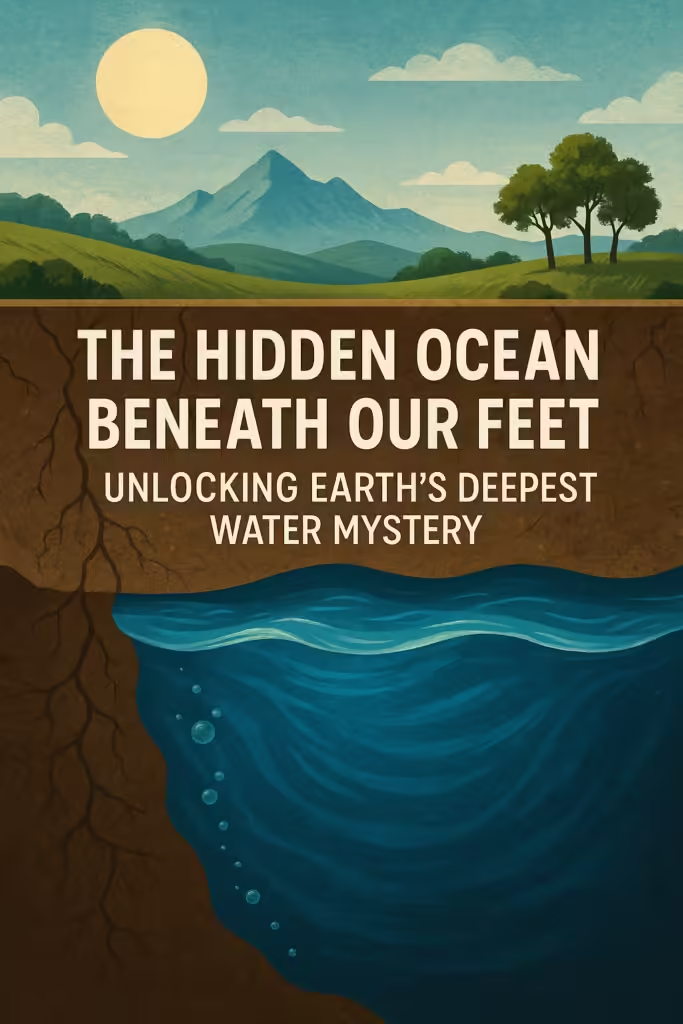
The Hidden Ocean Beneath Our Feet: Unlocking Earth’s Deepest Water Mystery
When we think of oceans, we imagine vast blue surfaces stretching across our planet—Pacific waves crashing on shores or deep trenches teeming with mysterious life. But what if one of Earth’s most immense water reservoirs isn’t visible at all? What if, instead of flowing between continents, it’s locked thousands of kilometers beneath our feet—inside rocks?
Welcome to one of modern geology’s most astonishing discoveries: a massive “hidden ocean” trapped in Earth’s mantle, not in liquid pools, but bound within the atomic structure of minerals. This revelation has not only revolutionized our understanding of the Earth’s interior but has reshaped how scientists view the planet’s ancient water cycle, tectonic movements, and even the origins of life-supporting oceans at the surface.
Beyond the Surface: Discovering the Deep Earth Reservoir
In 2014, scientists studying diamond inclusions discovered ringwoodite—a high-pressure form of olivine—containing a startling amount of water. The ringwoodite was found inside a diamond brought up from around 600 kilometers below the Earth’s surface. But it wasn’t wet in the traditional sense. Instead, the water existed as hydroxide ions (OH⁻), trapped inside the crystal lattice of the mineral.
This seemingly tiny detail triggered a seismic shift in Earth science. By analyzing how seismic waves travel through the planet’s interior, researchers found evidence that a vast layer in the mantle between 400 to 600 kilometers deep was saturated with water-rich minerals—an entire reservoir three times the volume of all surface oceans combined.
Water in Rock? Understanding Mineral-Bound Water
To grasp this phenomenon, imagine sponge-like rocks soaked with water not on their surfaces, but locked inside their mineral structures. At extreme temperatures and pressures deep inside the Earth, certain minerals behave like water storage units. Ringwoodite, wadsleyite, and other high-pressure phases of olivine can trap and transport water atoms within their crystalline matrices.
So while it’s not a traditional ocean of sloshing liquid, this mantle reservoir represents a gargantuan underground storage of hydrogen and oxygen, the essential components of H₂O, embedded directly into the planet’s geology. And it doesn’t just sit there passively—it actively participates in Earth’s dynamic systems.
Reshaping Geology: A New View of Earth’s Water Cycle
Before this discovery, scientists believed that Earth’s water cycle was largely confined to surface processes: evaporation, precipitation, rivers, and oceans. But the hidden ocean theory has changed everything.
Water from the surface doesn’t simply remain on top. Through a process called subduction, tectonic plates carry oceanic crust deep into the Earth’s mantle. As these plates descend, water trapped in sediments and rocks is dragged down too. At high pressures and temperatures, this water binds to mantle minerals and becomes part of the hidden reservoir.
Later, through volcanic eruptions and mantle plumes, some of this deeply stored water is returned to the surface, helping to regulate volcanic activity and influence continental formation. This means that the Earth’s internal water cycle may be just as vital—and massive—as the one we observe above ground.
Volcanic Clues: Water’s Role in Eruptions and Earthquakes
Why does this deep water matter? Because it plays a major role in tectonic activity and volcanic behavior. Water acts as a lubricant for tectonic plate movements and reduces the melting point of rocks, enabling magma to form more easily.
This explains why some of the most explosive volcanoes are located in subduction zones—regions where oceanic plates dive beneath continents and carry water deep into the Earth. The stored water lowers the melting point of surrounding rocks, creating magma chambers that can erupt violently.
Some geophysicists even speculate that variations in this mantle-stored water could influence the frequency of earthquakes, volcanic hotspots, and continental drift, making it one of the hidden forces shaping Earth’s surface evolution.
Did the Deep Ocean Create the Surface Oceans?
One of the most fascinating implications of this deep reservoir is its possible connection to the origins of surface oceans. Traditionally, scientists debated whether Earth’s water came from icy comets or outgassing from the planet’s interior. But the hidden ocean suggests a compelling new possibility.
If the mantle has held enormous quantities of water since Earth’s early history, it may have acted as a slow-release mechanism—gradually pushing water to the surface through volcanic activity over millions of years. In other words, Earth’s surface oceans might be the result of a slow, steady exhalation from the planet’s deep interior.
This theory has major implications for planetary science, too. If other rocky planets or moons once had similar mantle processes, they may have once harbored oceans—even if none remain today. Mars, for instance, shows signs of ancient rivers but no current seas. Could a “deep ocean” still be locked beneath its surface?
How Scientists Probe This Inaccessible Realm
You might be wondering: how do we know what’s happening hundreds of kilometers below Earth’s surface, where no drill has ever reached?
The answer lies in seismology—the study of how earthquake waves move through Earth. These waves behave differently depending on the density, composition, and temperature of the materials they pass through. Anomalies in wave behavior, especially in the transition zone (410–660 km deep), provided early clues to the presence of water-rich minerals.
In addition, lab experiments recreating deep Earth conditions allow scientists to test how minerals absorb and release water under pressure. Combined with diamond inclusions—tiny time capsules from the deep Earth—these tools give us an indirect but increasingly accurate picture of the mysterious inner ocean.
A Living Planet: The Deeper Meaning of Deep Water
The discovery of Earth’s deep water reservoir reinforces a powerful idea: our planet is far more dynamic, interconnected, and alive than we often imagine. From surface rain to molten lava, from thunderstorms to earthquakes, the rhythms of the planet are tied together by a vast, unseen system beneath our feet.
This hidden ocean also challenges us to rethink where life-sustaining resources can exist. As we search for water on distant moons like Europa or exoplanets far beyond our solar system, we must remember: not all oceans are blue and shimmering under sunlight—some are buried, silent, and woven into stone.
Final Thoughts: We’ve Only Scratched the Surface
We stand on the crust of a world still filled with secrets. The hidden ocean in the mantle—bound in crystal, fueled by subduction, and exhaled through volcanoes—represents one of the most profound geological discoveries of the 21st century.
It reminds us that Earth is not static but a breathing, recycling, evolving entity, shaped as much by what lies beneath as by what we see above. And it urges us to keep looking deeper—not just into rocks and minerals, but into the hidden processes that have made this planet uniquely habitable.
Because sometimes, the greatest oceans are the ones we don’t even see.


